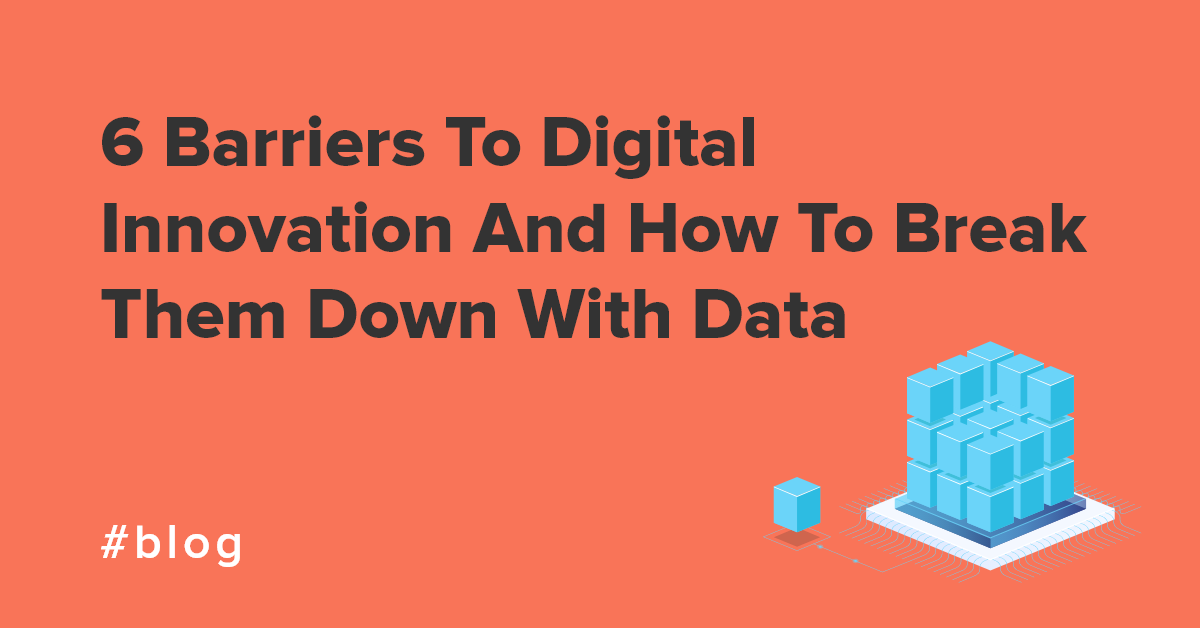Digital innovation drives efficiency, business intelligence, competitiveness, and your bottom line. But it’s no easy feat.
In fact, 70 percent of all digital initiatives fail to reach their goal. These failures mean businesses suffer financially and fall behind their more digital-savvy competitors.
It’s fair to say, then, that digital innovation is not an ‘if’, but rather a ‘when’. And, to ensure you create a successful digital-first transition, you’ll need to anticipate and mitigate the barriers ahead.
Here are six barriers and how data can break them down.
1. Not having the right infrastructure
Over 40 percent of survey respondents predicted legacy systems as one of the barriers to digital transformation in 2019.
Legacy systems can drain your IT budget, time and resources. Implementing security patches and updates, as well as continuous IT management, requires a lot of dedicated time from your IT department. Not to mention, complicated fixes can cost a large amount for outdated hardware.
The cloud is a more flexible, secure and scalable environment for innovative organizations. And, with the right data tools and migration strategy, you can move your legacy applications and data simply and without manual intervention.
2. Your high-value data is out of reach
Much like digging for oil, valuable data is often found in difficult to reach places.
This data is usually costly and time-consuming to find and utilize. But, without it, you’ll struggle to gather business insights and identify valuable opportunities.
Orchestrating your data through data integration can help uncover your high-value data and place it into one, central command center. From here, you can move forward with your digital transformation efforts.
3. Lack of data control
If your business teams require data but have to wait a long time to get it from IT teams, your speed of innovation will also suffer.
While self-service data tools can help, they contain only so much data.
Ideally, you need a useable platform that uses data pipelines to consolidate every application and data stream. This will help your IT teams find data faster and gain better control of your entire data ecosystem.
4. Siloed environments and miscommunication
Siloed environments inevitably stifle innovation. When you section off your data and knowledge, you hinder collaboration between teams within your organization. You also end up hiding potentially valuable data, and wasting money paying for storing data you don’t utilize.
To remedy this, your teams should embrace knowledge sharing and work together with a unified view of your data. This will also cut down on the likelihood of duplicated or low quality data.
In addition to this, identifying a ‘common’ data language between your IT and business teams will inform your data-driven projects and ensure there are no miscommunications along the way.
5. Tiresome manual processes
Manual processes take up your IT teams’ valuable time and can be unreliable. This means they often end up spending time cleaning and loading data rather than working on innovation.
Automating key data processes, such as data pipelines, data profiling and validation, and repetitive data jobs, can streamline your business’s efforts and create time for innovation.
6. Digital innovation readiness
To deliver on innovation, your organization needs to prepare for change management. From assigning project managers, to setting the right technological foundations in place, there are many aspects to optimizing for change management.
Planning your digital innovation strategy, from your people to your data platforms, will help to ease the change management process and avoid any future pitfalls.
Drive innovation with data
Data is the crux of digital innovation. After all, data provides you with the insights needed to inform your decisions and shape your business’s future.
However, digital innovation isn’t a simple task. Legacy systems and architectures, manual processes and siloed environments are just some of the barriers that stand in the way of your success.
Fortunately, with the right data platform, management and knowledge, you can overcome these challenges and make room for innovative, profitable growth.
Read more: Digital Transformation with CloverDX
By CloverDX
CloverDX is a comprehensive data integration platform that enables organizations to build robust, engineering-led, ETL pipelines, automate data workflows, and manage enterprise data operations.










